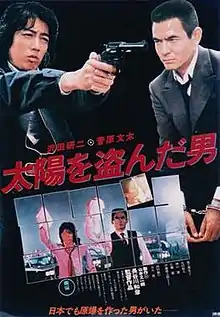Taiyō o Nusunda Otoko
Taiyō o Nusunda Otoko (太陽を盗んだ男), also known as The Man Who Stole the Sun, is a 1979 Japanese political satire spy film, directed by Hasegawa Kazuhiko[1][2] and written by Leonard Schrader.[3][4][5]
| Taiyō o Nusunda Otoko | |
|---|---|
 Theatrical poster | |
| Directed by | Kazuhiko Hasegawa |
| Produced by | Mataichiro Yamamoto |
| Written by | Leonard Schrader (story & screenplay) Kazuhiko Hasegawa (screenplay) |
| Starring | Kenji Sawada Bunta Sugawara |
| Music by | Takayuki Inoue |
| Cinematography | Tatsuo Suzuki |
| Edited by | Akira Suzuki |
Production company | Kitty Films |
| Distributed by | Toho Universal Pictures |
Release date | October 6, 1979 |
Running time | 147 min. |
| Country | Japan |
| Language | Japanese |
Plot
Makoto Kido (Kenji Sawada), a high school science and chemistry teacher, has decided to build his own atomic bomb. Before stealing plutonium isotopes from Tōkai Nuclear Power Plant, he is involved in the botched hijack of one of his school's buses during a field trip. Along with a police detective, Yamashita (Bunta Sugawara), he is able to overcome the hijacker and is publicly hailed as a hero.
Meanwhile, Makoto is able to extract enough plutonium from his stolen isotopes to create two bombs—one genuine, the other containing only enough radioactive material to be detectable, but otherwise a fake. He plants the fake bomb in a public lavatory and phones the police and demands that Yamashita take the case. Since Makoto speaks to the police through a voice scrambler, Yamashita is unaware that Makoto is behind the whole thing.
Makoto manages to extort the government into showing baseball games without cutting away for commercials. Flush with success, he follows a suggestion by a radio personality, nicknamed "Zero", to use the real bomb to extort the government into allowing the Rolling Stones to play in Japan (despite being barred from doing so due to Keith Richards being arrested for narcotics possession). The request is soon granted and the band eventually plays in Tokyo.
As Makoto makes his way to the concert, Yamashita follows him. Makoto pulls out a gun and forces Yamashita to a rooftop, bomb in a package he is carrying. Makoto reveals that he was the extortionist, and gets into a fight with Yamashita. Eventually the two fall from the roof whilst Makoto holds on to the bomb. He is saved by grabbing on to a power line as Yamashita falls to his death. Still in possession of the bomb, Makoto decides to leave. As he walks away, a ticking sound plays in the background. The film ends on a freeze frame of Makoto as the ticks stop and an explosion is heard before fanding to black.
Cast
- Kenji Sawada as Makoto Kido
- Bunta Sugawara as Inspector Yamashita
- Kimiko Ikegami as Zero Sawai
- Kazuo Kitamura as Tanaka
- Shigeru Kôyama as Nakayama
- Kei Satō as Dr. Ichikawa
Themes
Many elements of the film are similar to Dr. Strangelove or: How I Learned to Stop Worrying and Love the Bomb—namely, the satirical treatment of the proliferation of nuclear weapons. The film's specific area of satire is nuclear terrorism, which, as in the previous film, was a subject largely considered unsatirizeable. Several scenes in the film are considered controversial, such as a moment where Makoto uses scraps of plutonium metal to poison people in a public swimming pool. The film had a particular resonance for Japanese audiences; while Japan does use nuclear power, the country has long held against maintaining a nuclear arsenal especially in the aftermath of the bombings of Hiroshima and Nagasaki.
Much of the first hour of the film's running time is taken up with a highly technical depiction of Makoto building his homemade nuclear weapon, although key steps in the bomb-making process have apparently been omitted in the name of public safety.
The film won the Tokyo Blue Ribbon Award for Best Film of the Year in 1980, and was a critical and financial success in Japan on its release. It has only been released outside Japan on home video.
In 1986, the American film The Manhattan Project concerned a highly intelligent young man who makes his own atomic weapon.
Awards
Wins
- Best Supporting Actor—Bunta Sugawara, Japan Academy Prize[6]
- Best Film—Hochi Film Awards
- Best Actor—Kenji Sawada, Hochi Film Awards
- Best Japanese Director—Kazuhiko Hasegawa, Kinema Junpo Awards
- Best Director—Kazuhiko Hasegawa, Mainichi Film Award
- Readers' Choice Award—Kazuhiko Hasegawa, Mainichi Film Award
- Best Film, Yokohama Film Festival
- Best Director—Kazuhiko Hasegawa, Yokohama Film Festival
Japan Academy Prize
- Best Film
- Best Actor—Kenji Sawada
- Best Director—Kazuhiko Hasegawa
- Best Art Direction—Yoshinaga Yokoo
- Best Cinematography—Tatsuo Suzuki
- Best Lighting—Hideo Kumagai
- Best Sound—Kenichi Benitani
References
- "キネマ旬報が選ぶ1970年代日本映画ベストテン、第1位は「太陽を盗んだ男」". ナタリー (in Japanese). Retrieved 2021-01-07.
- "太陽を盗んだ男とは". 広島国際映画祭 (in Japanese). Retrieved 2021-01-07.
- "太陽を盗んだ男とは". kotobank (in Japanese). Retrieved 2021-01-07.
- "伝説的傑作カリスマ映画『太陽を盗んだ男』のDVD製作記者会見。 長谷川監督の語る当時のいきさつ". シネマトピックス (in Japanese). Retrieved 2021-01-07.
- "遂にVIDEO&DVD解禁". アミューズ (in Japanese). Retrieved 2021-01-07.
- "Awards for Taiyo o nusunda otoko". IMDb. Retrieved 2009-04-25.
External links
- Taiyo o nusunda otoko (1979) at IMDb
- 太陽を盗んだ男 (in Japanese). JMDB.